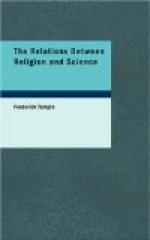Soon a distinction grows up between the things that seem to have a spontaneous motion and those that have not, and spontaneous motion is taken as the sign of life. And all inanimate things, of whatever kind, are held to be moved, if they move at all, by a force outside themselves. Their own force is limited to that of resisting, and does not include that of originating motion. But though they cannot originate motion they are observed to be capable of transmitting it. And the notion of force is expanded by the recognition that it can be communicated from one thing to another and yet to another, and that we may have to go back many steps before we arrive at the will from which it originated. We began with the notion of a power the action of which was or appeared to be self-originated: we come to the notion of a power the action of which is nothing more than the continuance of preceding action. And the special characteristic of the action of this force as thus conceived, which we may call the derivative force, is seen to be its regularity, just as the special characteristic of the self-originating action was its spontaneity.
As experience increases the regularity of the action of the derivative force is more and more observable, and then arises the notion of a law or rule regulating the action of every such force. And a perpetually increasing number of phenomena are brought under this head, and are shown to be, not the immediate results of self-originating action, but the more or less remote results of derivative action governed by laws. And even a large number of those phenomena, which specially belong to life and living creatures, in whom alone, if anywhere, the self-originating action is to be found, are observed to be subject to law and therefore to be the issue not of self-originating but of derivative action. And this observed regularity it is found possible to trace much more widely than it is possible to trace any clear evidence of what we understand by force. And so, at last, we frequently use the word force as it were by anticipation, not to express the cause of the phenomena, which indeed we do not yet know, but as a convenient abbreviation for a large number of facts classed under one head. And this it is which enables Hume to maintain that we mean no more by a cause than an event which is invariably followed by another event. We discover invariability much faster than we can discover causation; and having discovered invariability in any given case, we presume causation even when we cannot yet show it, and use language in accordance with that presumption. Thus, for instance, we speak of the force of gravitation, although we cannot yet prove that there is any such force, and all that we know is that material particles move as if such a force were acting on them.
As Science advances it is seen that the regularity of phenomena is far more important to us than their causes. And the attention of all students of Nature is fixed on that rather than on causation. And this regularity is seen to be more and more widely pervading all phenomena of every class, until the mind is forced to conceive the possibility that it may be absolutely universal, and that even will itself may come within its supreme dominion.




